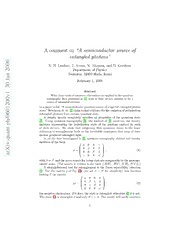
A comment on "A semiconductor source of entangled photons" PDF
Preview A comment on "A semiconductor source of entangled photons"
A comment on “A semiconductor source of entangled photons” 6 0 N. H. Lindner, J. Avron, N. Akopian, and D. Gershoni 0 2 Department of Physics n Technion, 32000 Haifa, Israel a J February 1, 2008 0 3 Abstract 1 v Whenbasictoolsofquantuminformation areappliedtothequantum 0 tomography data presented in [1], none of their devices appears to be a 0 source of entangled photons. 2 1 Inapapertitled“Asemiconductorquantumsourceoftriggeredentangledphoton 0 pairs”Stevensonet.al. [1]claimtofindevidencefortheemissionofpolarization 6 entangled photons from certain quantum dots. 0 A density matrix completely specifies all properties of the quantum state / h [2]. Using quantum tomography [3], the authors of [1] construct the density p matrices representing the polarization state of the photons emitted by each - t of their devices. We show that subjecting their quantum states to the basic n definition of entanglement leads to the inevitable conclusion that none of their a u devices produced entangled light. q In all the dots investigatedin [1], quantum tomographyyielded realdensity v: matrices of the form α 0 0 γ i X 0 β 0 0 r ρ= 0 0 β′ 0 , (1) a γ 0 0 α′ withβ ≈β′ andthe zerosstandsfortermsthatarecomparabletothemeasure- ments’ noise. (The matrix is written in the basis {|HHi,|HVi,|VHi, |VVi}.) A straightforward test for entanglement is the Peres separability criterion [4]. For the matrix ρ of Eq. (1), (we set β = β′ for simplicity) this involves looking if the matrix α 0 0 0 0 β γ 0 ρ = . (2) P 0 γ β 0 0 0 0 α′ hasnegativeeigenvalues. Ifitdoes,thestateisentangled;otherwise[6]itisnot. The state (1) is entangled if and only if γ >β. The reader will easily convince 1 himself by inspecting the tomographic data in [1] that this is never the case for any of the measured states. Forthecaseathandonecanshowthatthemeasuredstatesareallunentan- gledevenwithout the Perescriterion. For the sakeof simplicity we take α=α′ and β =β′. In this case the matrix in Eq. (1) can be written as [7]: ρ = (α−γ) ρzˆ⊗ρzˆ+ρ−zˆ⊗ρ−zˆ +(β−γ) ρzˆ⊗ρ−zˆ+ρ−zˆ⊗ρzˆ (cid:0) (cid:1) (cid:0) (cid:1) +γ ρxˆ⊗ρxˆ+ρ−xˆ⊗ρ−xˆ+ρ−yˆ⊗ρyˆ+ρyˆ⊗ρ−yˆ (3) (cid:0) (cid:1) where the single qubit state ρnˆ ≥0 is defined by I+nˆ·~σ ρ = (4) n 2 ~σ =(σ ,σ ,σ ) is the vector of Pauli matrices; nˆ a unit vector in three dimen- x y z sionsandItheidentitymatrix. Evidently,ρisaconvexcombinationofproduct states for all β ≥ γ and α ≥ β and agrees with the definition of a separable (unentangled) state. Since this is the case for the tomographic data for all the dots in [1] none of them produced an entangled state. As the above analysis shows, the emergence of off-diagonal terms for dots with “which path” spectral ambiguity is not a satisfactory evidence for entan- glement as the authors of [1] claim. The authors also subject their data to an additional tests of entanglement. This test involves further processing of the data that discards a significant part of the photon counts. Our analysis applies the definition of entanglement (alternatively the Peres criterion) to the quantumstate as measuredby quantum tomography. Thus any correcttest for entanglement must agree with our conclusions when applied to the same data. In conclusion, either the quantum tomography data of the dots studied in [1] is reliable and then none of the quantum states produced in the experiment corresponds to entangled photons; or the tomography data are not of sufficient quality and no definite conclusion can be drawn from the experiment. Note added: After the above criticism was communicated to the authors of [1], they have posted a new paper on the arXiv preprint server, describing resultsofanewexperiment. Inthispreprinttheyreferto[1]asthefirstdemon- stration of emission of entangled photon pairs from quantum dots. In light of the above, this claim is false. In fact, the first correct demonstration can be found in [8]. Acknowledgment: This work is supported by the ISF. References [1] Stevenson, R. M., Young, R. J. Atkinson P., Cooper, K., Ritchi e D. A., Shields A. J., A semiconductor source of triggeredentangled photon pairs, Nature 439 179, (2006). 2 [2] Peres A., Quantum Theory: Concepts and Methods, Kluwer (Dordrecht) (1993). [3] Kwiat, P.G., Waks, E., White, A.G., Appelbaum, L. Eberhard, P.H., Ul- trabright source of polarization-entangled photons. Phys.Rev.A60, R773 (1999). [4] Peres,A., SeparabilityCriterionforDensity Matrices,Phys.Rev.Lett.77, 1413 (1996) [5] M.Horodecki,P.Horodecki,andR.Horodecki,Mixed-StateEntanglement and Distillation: Is there a Bound Entanglement in Nature?, Phys. Rev. Lett. 80, 52395242(1998) [6] M. Horodecki, P. Horodecki, and R. Horodecki, Separability of mi xed states: necessary and sufficient conditions, Phys. Lett. A 223, 1 (1996), quant-ph/9605038. [7] The following command lines compute the tensor product of matrices in Mathematica: Needs["LinearAlgebra‘MatrixManipulation‘"] KroneckerProduct[a_?SquareMatrixQ, b_?SquareMatrixQ]:= BlockMatrix[Outer[Times,a,b]] [8] N. Akopian, N.H. Lindner, E. Poem. Y. Berlatzky, J. Avron, D. Gershoni, D.B. Gerardot and P.M. Petroff, Entangled photon pairs from a semicon- ductor quantum dot, quant-ph/0512048 3
